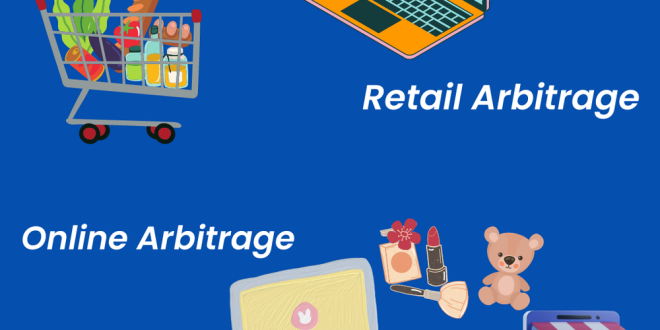For those diving into the world of Amazon, online arbitrage is one way to find profitable deals and turn them into a steady stream of income. Online arbitrage involves purchasing products from one online retailer at a low price and reselling them on Amazon for a profit. It sounds simple, but success with Amazon online arbitrage comes from understanding the right tools, techniques, and strategies. Let’s go through how to spot the best deals, make savvy purchasing decisions, and turn these buys into profits on Amazon.
What is Amazon Online Arbitrage?
Amazon online arbitrage is the process of buying items from other online marketplaces, often at discounted rates, and reselling them on Amazon at a higher price. This model allows sellers to capitalize on price differences across platforms without needing to manage inventory from physical retail stores.
The approach leverages the idea that price differences often exist due to various discounts, clearances, or exclusive deals that Amazon may not always reflect. While retail arbitrage involves sourcing from physical stores, online arbitrage removes that need, allowing sellers to browse and source entirely online.
Why Online Arbitrage is a Popular Model for Amazon Sellers
Online arbitrage has become popular because it allows sellers to start with minimal investment, requiring only an internet connection and some research skills. Sellers enjoy the flexibility of sourcing from multiple online stores, which saves time and opens up access to a wide variety of products and categories.
The other draw is scalability. Online arbitrage doesn’t require significant overhead, and with a system in place, it’s possible to turn it into a steady income stream. By consistently monitoring price trends, researching products, and optimizing listings, sellers can scale their online arbitrage business without facing the challenges of traditional inventory management.
Getting Started with Online Arbitrage: Essential Tools and Resources
If you’re new to online arbitrage, the right tools can make all the difference. Using software that tracks prices, analyzes market trends, and offers insights into sales history is key to finding profitable items. Some popular tools among Amazon sellers arbitrage include:
- Price Tracking Software: Tools like Keepa or CamelCamelCamel allow you to monitor price fluctuations on Amazon, helping you determine if an item is a good buy at a specific price.
- Product Research Tools: Software like Jungle Scout or Helium 10 can show you data on product sales, competition levels, and keywords, making it easier to choose profitable items.
These tools enable you to make data-driven decisions, minimizing the risk of purchasing items that might not sell well or at all. Additionally, some arbitrage sellers use browser extensions that instantly show Amazon sales rank, fees, and potential profits when browsing other online stores.
How to Identify Profitable Products for Online Arbitrage
Identifying profitable products is the cornerstone of successful online arbitrage. Start by narrowing down categories where you can find consistent discounts or items that tend to sell well on Amazon. Categories like toys, beauty, and electronics often provide good margins, but it’s essential to conduct detailed research for each product.
When selecting products, always consider the following:
- Amazon Sales Rank: A lower rank usually means higher sales volume. Use the sales rank as an indicator of demand but remember to check for seasonal fluctuations and recent price trends.
- Profit Margin: After Amazon fees and shipping costs, the item should still yield a healthy profit. Use the Fulfillment by Amazon (FBA) revenue calculator to estimate fees and shipping costs accurately.
By focusing on sales rank and margin, you avoid making common mistakes such as buying products with no demand or underestimating Amazon’s fees.
Calculating Costs and Profits: Understanding Amazon Fees
A critical aspect of online arbitrage is understanding Amazon’s fee structure. Fees vary depending on the product category, size, weight, and fulfillment method (FBA or FBM). Amazon’s FBA fees, which cover picking, packing, and shipping, are a convenient option, but they can eat into profits if not calculated correctly.
- Referral Fees: Amazon charges a percentage of each sale, which varies by category. It’s essential to factor in these fees when determining a product’s profitability.
- FBA Fees: If you’re using Amazon FBA, include the costs for fulfillment, which vary based on product weight and dimensions. The FBA Revenue Calculator can help with these calculations.
- Storage Fees: Amazon charges monthly storage fees based on your inventory volume. Seasonal fluctuations can increase these fees, particularly during holiday periods.
Knowing your total costs lets you set a competitive price on Amazon while still retaining a decent profit margin.
Strategies for Finding the Best Online Deals
Finding profitable deals for online arbitrage requires a systematic approach. First, set up alerts on major retailer sites for when items go on sale. Many sellers rely on websites that track discounts, such as Slickdeals, Honey, and Rakuten.
Other tips for sourcing profitable deals include:
- Stacking Discounts: Look for ways to combine promotions, discount codes, and cashback offers to maximize savings. For instance, pairing a site-wide sale with a cashback app can create an even better deal.
- Focusing on Seasonal Sales: Major shopping holidays like Black Friday, Cyber Monday, and seasonal clearances offer significant discounts that can be ideal for arbitrage sellers.
These tactics help you find products at lower prices, which translates to better margins when you resell on Amazon.
Listing and Optimizing Your Products for Amazon Sales
Once you’ve sourced your products, the next step is to list and optimize them on Amazon. Product listings with high-quality images, keyword-rich descriptions, and competitive pricing tend to perform better. When creating a listing, focus on:
- Keywords: Include relevant keywords in the title, bullet points, and description to improve visibility. Keyword research tools can help identify popular search terms related to your product.
- Pricing Strategy: Set a price that covers your costs, including fees, while remaining competitive. A competitive price can boost your chances of winning the Buy Box, which is critical for maximizing sales.
Optimized listings help your products stand out and improve the chances of converting views into sales.
The Importance of Repricing for Online Arbitrage Success
The Amazon marketplace is highly competitive, so regular repricing is vital for maintaining profitability. Automated repricing tools adjust your prices based on competitor listings, keeping your products competitive without constant monitoring. This strategy ensures that you stay competitive, especially if others are selling the same item.
Effective repricing can help you win the Buy Box more often, which increases sales velocity and improves your ranking. However, it’s essential to avoid pricing wars, as repeatedly lowering prices can erode profits. Instead, aim for strategic repricing that balances competitiveness with profitability.
Potential Challenges in Amazon Online Arbitrage
While Amazon online arbitrage can be profitable, it also has its challenges. Market fluctuations, price wars, and product restrictions are common obstacles that sellers face. Amazon frequently changes its seller policies and sometimes restricts specific brands or products, so staying updated on policy changes is crucial.
Another challenge is managing inventory. Overstocking can lead to high storage fees, while understocking may result in missed sales opportunities. Using sales history and forecasting tools can help strike the right balance.
Final Thoughts on Turning Deals into Profits with Amazon Online Arbitrage
Amazon online arbitrage offers a practical and scalable way to build a profitable business with minimal upfront costs. By understanding how to source deals, calculate profits, and navigate Amazon’s fees, sellers can turn great buys into reliable revenue streams.
With the right tools, strategies, and an eye for a good deal, online arbitrage can be a rewarding way to generate profits on Amazon while keeping costs low and margins high.
 Diverse Perspectives: Insights & Stories Exploring Ideas, Sharing Knowledge
Diverse Perspectives: Insights & Stories Exploring Ideas, Sharing Knowledge





